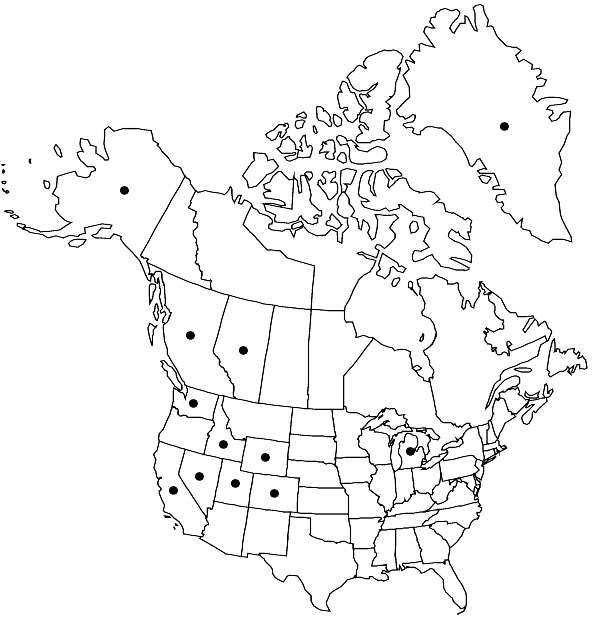Schistidium confertum
Bryol. Europ. 3: 99. 1845,.
Plants in compact, often flattish cushions or tufts, olivaceous, brown, or yellow-brown, rarely nearly black. Stems 0.3–1.2(–2) cm, central strand narrow or absent. Leaves erect, sometimes slightly curved, imbricate when dry, ovate-lanceolate to ovate-triangular, obtusely keeled or concave proximally, sharply keeled distally, 0.8–1.8(–2) mm, 1-stratose or 2-stratose in striae distally; margins recurved in medial sections, usually less recurved on one side of leaf, rarely plane, smooth, 2-stratose, occasionally 3-stratose; apices usually acute, rarely sub-obtuse; costa percurrent or excurrent as a short, spinulose-denticulate, often flexuose awn, smooth; basal marginal cells quadrate or short-rectangular, transverse walls usually thicker than longitudinal walls, sometimes trigonous; distal cells mostly isodiametric, rounded or angular, or short-rectangular, 5–8 µm wide, smooth, weakly sinuose. Sexual condition autoicous. Capsule yellow-brown or light reddish brown, short-cylindric or cupulate, rarely campanulate, rarely becoming finely striate with age, (0.5–)0.7–1 mm; exothecial cells mostly short-elongate, mixed with patches of angular isodiametric cells, walls unevenly thickened, trigonous; stomata present; peristome patent to squarrose, sometimes twisted, 230–320 µm, orange or yellowish red, coarsely papillose, usually strongly perforated and with uneven margins. Spores 8–12 µm, smooth or granulose.
Phenology: Capsules mature late spring to early summer.
Habitat: Rocks in somewhat shaded habitats
Elevation: moderate to high elevations (1000-3200 m)
Distribution

Greenland, Alta., B.C., Alaska, Calif., Colo., Idaho, Mich., Nev., Utah, Wash., Wyo., Eurasia.
Discussion
Schistidium confertum is one of the smaller species of the genus. It can be confused with S. dupretii and S. frigidum. Schistidium dupretii is distinguished by its consistently striate, larger, darker, and more cylindrical capsules and its oblate basal marginal laminal cells versus the quadrate or longitudinally short- rectangular marginal cells of S. confertum. Also, S. dupretii lacks the thicker transverse walls that characterize the basal marginal cells of S. confertum. The leaf margins of S. confertum are more weakly recurved than in S. dupretii, and it is usually olivaceous, often with yellowish or brownish tones, whereas S. dupretii is generally evenly brown.
Selected References
None.